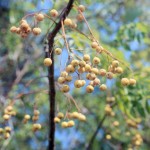Chinaberry
Melia azedarach
Meliaceae
Description
Chinaberry is a tree that grows up to 50 feet tall with a broad, spreading, rounded crown. The large leaves of up to 15 inches long have leaflets of up to 3 inches long.
Loose clusters of purplish, fragrant flowers give rise to hanging clumps of smooth single-seeded fruits about 0.5 to 0.75 inch in diameter. The clusters of fruit ripen to yellow in the fall and often persist on the tree through the winter.
Habitat
These introduced trees were widely planted as ornamentals in the eastern two-thirds of Texas. Many have escaped and may be found in thickets, floodplain woods and borders of woods.
Toxic Agent
Meliatoxins A1, A2 and A3 are responsible for the toxicity of these plants. They are found in highest concentration in the fruit, but the bark, leaves and flowers are also poisonous.
Many species - including cattle, sheep, goats, pigs, dogs, rats, rabbits, guinea pigs, poultry and humans - have been poisoned by chinaberry. Pigs and dogs are poisoned most frequently, usually by ingesting fallen fruits. They show clinical signs within 2 to 4 hours of consumption.
Signs of Livestock Ingestion
The clinical signs are related to the gastrointestinal and/or nervous system and include: Anorexia; Vomiting; Diarrhea; Constipation; Excitation; Incoordination; Depression; Convulsions.
Animals surviving for 24 hours have a good chance of recovery. Rarely do clinical signs last longer than 48 hours. Most cases result from animals consuming the fruit from the ground.
Because this intoxication is rapid, the hard, ribbed pit from the fruit is easily identifiable from the stomach contents of dead animals.
Management Strategies
Remove chinaberry trees from the area of pens used for swine. Other animals should not be forced to consume the bitter fruit.
Images
Plant Characteristics
Flower Color: White
Seed Type: Fruit/Berry
Duration: Perennial
Stem Texture: Hairless/Smooth
Leaf Shape
 : Bipinnately Compound
: Bipinnately Compound
Season: Warm
Distribution
 : 01 - Pineywoods, 02 - Gulf Prairies and Marshes, 03 - Post Oak Savannah, 04 - Blackland Prairies, 05 - Cross Timbers and Prairies, 06 - South Texas Plains, 07 - Edwards Plateau, 08 - Rolling Plains
: 01 - Pineywoods, 02 - Gulf Prairies and Marshes, 03 - Post Oak Savannah, 04 - Blackland Prairies, 05 - Cross Timbers and Prairies, 06 - South Texas Plains, 07 - Edwards Plateau, 08 - Rolling Plains
Distributions
Distribution refers to the ecological region in Texas that a plant has been found. You can also view a clickable map.
Book: Toxic Plants of Texas (B-6105)
Collection: Toxics
Livestock Affected: Cattle, Goats, Horses, Pigs, Sheep
Livestock Signs: Abdominal Pain, Anorexia, Colic, Convulsions, Depression/ Weakness, Diarrhea, Excitability, Incoordination, Vomiting/Regurgitation





